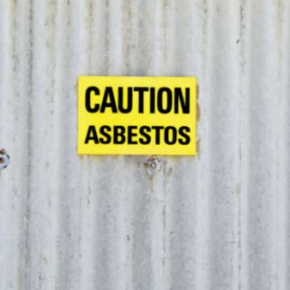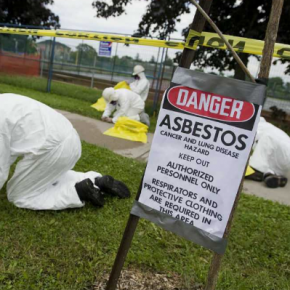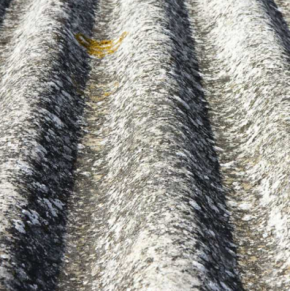
GUEST ARTICLE: Biggest asbestos exposure risk factors and how to avoid them
Exposure to asbestos can lead to a number of debilitating medical conditions, and this has meant the material has a reputation for being dangerous. Interestingly, however, asbestos is only dangerous in certain scenarios. Asbestos exposure only occurs when fibres from the material are allowed to enter the atmosphere and can be breathed into the lungs.
Asbestos was banned entirely from use in 1999, however it can still be found in many homes and businesses across the UK. This means that it is still possible to be exposed to asbestos if you are not sufficiently careful. So here are some biggest asbestos exposure risk factors and how you can avoid them.
========================
Working with asbestos
There is no doubt that the greatest risk for exposure to asbestos comes from professions that work with the material. It is a different story today, where working with asbestos is regulated and controlled, but in the past this was not the case. People worked with asbestos covering many industries, as the dangers of the substance were not known.
Given the way now know that it can take up 40 years for symptoms to present from asbestos exposure, it means it is still relevant today. If you previously worked in an industry that caused you to come into direct contact with asbestos, such as mining or building, then you need to be extra vigilant about the symptoms developing.
Thankfully today asbestos has been banned from use, so the only industry that has direct contact is that of asbestos specialists dealing with testing, analysis and removal. However, as all the necessary precautions are taken, this is not a dangerous industry.
Removing asbestos
There is still a lack of understanding surrounding asbestos, and this leads to risk factors. For example, if you discover asbestos in your property, you might assume that the safest way to deal with it would be to simply remove it as soon as possible. But this can actually put you at an enormous risk of dangerous exposure. This article provides more helpful information on asbestos removal, and how to deal with it safely.
As previously discussed, asbestos is only a danger to you when it is able to become airborne. This occurs when the material is moved or disturbed. So if you attempt to move asbestos without proper training or an understanding of the dangers you can inadvertently expose yourself to it.
If you do find that you have asbestos anywhere on your property then you should get in contact with removals specialists as soon as possible. They will be able to advise as to whether you need to have the asbestos removed or if it is actually fine to stay where it is.
Carrying out DIY tasks
Doing some DIY around the house might seem completely innocent, but if you have asbestos in your property this can actually become very dangerous. For example, you might wish to add new roof tiles to your garden shed and want to spend a weekend getting it sorted.
However, you might not be aware that asbestos is often contained in the tiles of older garden shed rooves. This means you can be exposed if you carelessly remove these tiles. Additionally, asbestos can be contained in ceiling coatings such as Artex – so attempting to remove this may expose you to asbestos.
Before you carry out any kind of DIY you need to ensure that you are completely confident that you will not be disturbing any asbestos during the process.
Working in the vicinity of asbestos
We have established earlier that there are no industries in which workers are expected to deal directly with asbestos without experience and training, however, it is also important to note that you can be at risk if you work anywhere that asbestos is in the vicinity. So this could be any job where you expected to be near asbestos-containing materials – this could be anyone from plumbers and electricians to carpenters and mechanics.
While asbestos is safe in the majority of cases if it is undisturbed, it is worth noting that the material can deteriorate over time which can lead to fibres being released into the atmosphere. This is why it is essential to check whether asbestos is present on any job you carry out and to take appropriate precautions.
Latest news

7th March 2025
ASSA ABLOY and Lorient Showcasing at the Fire Safety Event
ASSA ABLOY and Lorient are excited to announce their debut at the UK’s fastest-growing fire safety exhibition, the Fire Safety Event, taking place at the NEC, Birmingham, from 8 – 10 April 2025.
Posted in Access Control & Door Entry Systems, Architectural Ironmongery, Articles, Building Industry Events, Building Industry News, Building Products & Structures, Building Regulations & Accreditations, Building Services, Doors, Exhibitions and Conferences, Facility Management & Building Services, Health & Safety, Innovations & New Products, Posts, Restoration & Refurbishment, Retrofit & Renovation, Security and Fire Protection, Seminars
7th March 2025
Kent Company Wins Big With IronmongeryDirect’s TradeXtra Prize Draw
IronmongeryDirect, the UK’s leading online ironmongery specialist, is excited to announce the winner of its TradeXtra prize draw.
Posted in Access Control & Door Entry Systems, Architectural Ironmongery, Articles, Awards, Building Industry Events, Building Industry News, Building Products & Structures, Competitions, Doors, Innovations & New Products, Restoration & Refurbishment, Retrofit & Renovation, Security and Fire Protection, Videos
7th March 2025
Origin launches OW-70 Soho Window to revolutionise steel-look market
Origin, the UK’s leading manufacturer of premium aluminium windows and doors, has launched its groundbreaking OW-70 Soho Window.
Posted in Aluminium Products, Architectural Ironmongery, Articles, Building Industry News, Building Products & Structures, Building Systems, Doors, Glass, Glazing, Innovations & New Products, Restoration & Refurbishment, Retrofit & Renovation, Windows
6th March 2025
GEZE UK: Seeking Support at the National Fenestration Awards
GEZE UK is seeking support from industry professionals, clients and partners at the upcoming National Fenestration Awards, taking place on 25th October 2025, where the company is hoping to be shortlisted in five key categories.
Posted in Access Control & Door Entry Systems, Architectural Ironmongery, Articles, Awards, Building Industry Events, Building Industry News, Building Products & Structures, Building Services, Doors, Exhibitions and Conferences, Facility Management & Building Services, Health & Safety, Recruitment, Restoration & Refurbishment, Retrofit & Renovation, Security and Fire Protection, Windows
 Sign up:
Sign up: 
